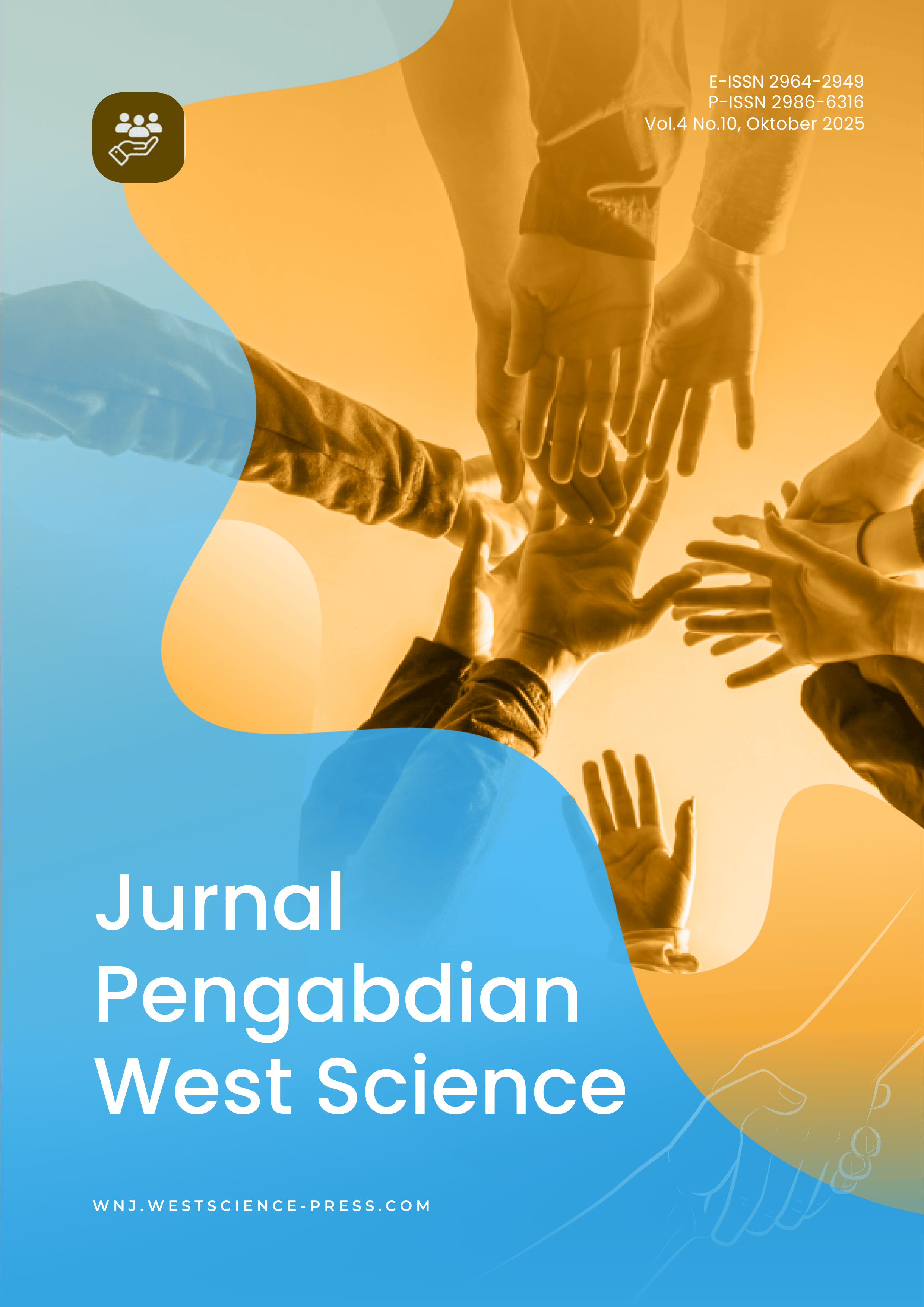Edukasi Anti Bullying: Strategi Pencegahan Bullying di SDIT Al-Hasanah dan SDN Kandang Panjang 03
DOI:
https://doi.org/10.58812/jpws.v4i10.2728Kata Kunci:
Bullying, Sekolah Dasar, Edukasi, Pencegahan, SDIT Al-Hasanah, SDN Kandang Panjang 03Abstrak
Bullying merupakan bentuk kekerasan yang marak terjadi di sekolah, termasuk Sekolah Dasar, dengan dampak negatif pada aspek psikologis, sosial, dan akademik anak. Fenomena ini juga menjadi perhatian global terkait hak anak atas pendidikan yang aman. Penelitian Olweus (1993) menunjukkan efektivitas program intervensi menyeluruh dalam menekan insiden bullying, sementara Smith et al. (2004) menyoroti peran guru dan kebijakan sekolah. Di Indonesia, Suryani & Fithriani (2021) menemukan bahwa pendekatan berbasis budaya lokal dapat meningkatkan efektivitas pencegahan bullying. Artikel ini membahas urgensi edukasi anti bullying sejak dini di SD, strategi implementasi, tantangan, dan solusi inovatif berbasis kebijakan serta praktik pendidikan. Metode yang digunakan adalah studi literatur sistematis dari penelitian nasional dan internasional tahun 2000– 2025. Hasil kajian menunjukkan edukasi anti bullying mampu mengurangi kekerasan, meningkatkan empati siswa, memperkuat kolaborasi orang tua- guru, serta membangun iklim sekolah positif.
Referensi
Arseneault, L., Bowes, L., & Shakoor, S. (2010). Bullying victimization in youths and mental health problems: ‘Much ado about nothing’? Psychological Medicine, 40(5), 717–729. https://doi.org/10.1017/S0033291709991383
Astuti, R. (2019). Peran guru dalam mencegah bullying di sekolah dasar. Jurnal Ilmiah Pendidikan Dasar, 6 (2), 123–135.
Baldry, A. C., & Farrington, D. P. (2007). Effectiveness of programs to prevent school bullying. Victims & Offenders, 2 (2), 183–204.
Bandura, A. (1977). Social learning theory. Englewood Cliffs, NJ: Prentice Hall.
Bronfenbrenner, U. (1979). The ecology of human development: Experiments by nature and design. Harvard University Press.
Coloroso, B. (2007). The bully, the bullied, and the bystander: From preschool to high school— how parents and teachers can help break the cycle of violence. HarperCollins.
Craig, W., & Pepler, D. (2007). Understanding bullying: From research to practice.
Canadian Psychology, 48 (2), 86–93. https://doi.org/10.1037/cp2007012
Cross, D., Pintabona, Y., Hall, M., Hamilton, G., & Erceg, E. (2011). Validated guidelines for school-based bullying prevention and management. International Journal of Mental Health Promotion, 13(4), 1–17. https://doi.org/10.1080/14623730.2011.9721784
Erikson, E. H. (1993). Childhood and society. WW Norton & Company.
Espelage, D. L., & Swearer, S. M. (2003). Research on school bullying and victimization: What have we learned and where do we go from here? School Psychology Review, 32(3), 365–383.
Espelage, D. L., & Swearer, S. M. (Eds.). (2004). Bullying in American schools: A social- ecological perspective on prevention and intervention. Routledge.
Fikriyah, S., Mayasari, A., Ulfah, U., & Arifudin, O. (2022). Pencegahan perilaku bullying melalui pendidikan karakter di lingkungan sekolah. Jurnal Pendidikan Sosial dan Budaya, 9 (1), 45–56.
Gini, G., Albiero, P., Benelli, B., & Altoè, G. (2007). Does empathy predict adolescents’ bullying and defending behavior? Aggressive Behavior, 33(5), 467–476.
Goleman, D. (1995). Emotional intelligence: Why it can matter more than IQ. Bantam Books.
Hinduja, S., & Patchin, J. W. (2010). Bullying, cyberbullying, and suicide. Archives of Suicide Research, 14(3), 206–221. https://doi.org/10.1080/13811118.2010.494133
Hinduja, S., & Patchin, J. W. (2015). Bullying beyond the schoolyard: Preventing and responding to cyberbullying (2nd ed.). Thousand Oaks, CA: Sage Publications.
Hong, J. S., & Espelage, D. L. (2012). A review of research on bullying and peer victimization in school: An ecological system analysis. Aggression and Violent Behavior, 17(4), 311–322. https://doi.org/10.1016/j.avb.2012.03.003
Hymel, S., & Swearer, S. M. (2015). Four decades of research on school bullying: An introduction. American Psychologist, 70 (4), 293–299.
Jolliffe, D., & Farrington, D. P. (2006). Examining the relationship between low empathy and bullying. Aggressive Behavior, 32(6), 540–550. https://doi.org/10.1002/ab.20154
Jolliffe, D., & Farrington, D. P. (2006). Examining the relationship between low empathy and bullying. Aggressive Behavior, 32(6), 540–550.
Kohlberg, L. (1981). The philosophy of moral development: Moral stages and the idea of justice. Harper & Row.
Kowalski, R. M., Giumetti, G. W., Schroeder, A. N., & Lattanner, M. R. (2014). Bullying in the digital age: A critical review and meta-analysis of cyberbullying research among youth. Psychological Bulletin, 140(4), 1073–1137. https://doi.org/10.1037/a0035618
KPAI. (2021). Data kasus bullying di Indonesia. Komisi Perlindungan Anak Indonesia. https://www.kpai.go.id
Kurniawati, D. (2020). Pencegahan bullying melalui pendidikan karakter di sekolah dasar. Jurnal Pendidikan Karakter, 10(1), 1–12.
Menesini, E., & Salmivalli, C. (2017). Bullying in schools: The state of knowledge and effective interventions. Psychology, Health & Medicine, 22 (1), 240–253. https://doi.org/10.1080/13548506.2017.1279740
Nansel, T. R., Overpeck, M., Pilla, R. S., Ruan, W. J., Simons-Morton, B., & Scheidt, P. (2001). Bullying behaviors among US youth: Prevalence and association with psychosocial adjustment. JAMA, 285 (16), 2094–2100. https://doi.org/10.1001/jama.285.16.2094
Olweus, D. (1993). Bullying at school: What we know and what we can do. Blackwell Publishing.
Puspitasari, E. (2018). Program sekolah ramah anak sebagai upaya pencegahan bullying. Jurnal Pendidikan Anak, 7(1), 45–57.
Rigby, K. (2002). New Perspectives on Bullying. London: Jessica Kingsley Publishers. Rigby, K. (2003). Consequences of bullying in schools. The Canadian Journal of
Psychiatry, 48(9), 583–590. https://doi.org/10.1177/070674370304800904 Rigby, K. (2007). Bullying in schools: And what to do about it. ACER Press.
Rigby, K. (2008). Children and bullying: How parents and educators can reduce bullying at school. Blackwell Publishing.
Salmivalli, C. (2010). Bullying and the peer group: A review. Aggression and Violent Behavior, 15 (2), 112–120. https://doi.org/10.1016/j.avb.2009.08.007
Salmivalli, C., Lagerspetz, K., Björkqvist, K., Österman, K., & Kaukiainen, A. (1996). Bullying as a group process: Participant roles and their relations to social status within the group. Aggressive Behavior, 22 (1), 1–15. https://doi.org/10.1002/(SICI)1098-2337(1996)22:1
Sari, N. (2021). Edukasi anti bullying pada siswa SD melalui pendekatan PPKN. Jurnal Moral Kemasyarakatan, 8 (1), 33–44.
Setiawan, H. (2020). Strategi pembelajaran berbasis empati untuk mencegah bullying di sekolah dasar. Jurnal Ilmu Pendidikan Dasar, 5 (3), 210–220.
Skiba, R., & Peterson, R. (1999). The dark side of zero tolerance: Can punishment lead to safe schools? Phi Delta Kappan, 80(5), 372–382.
Smith, P. K., & Brain, P. (2000). Bullying in schools: Lessons from two decades of research. Aggressive Behavior, 26(1), 1–9. https://doi.org/10.1002/(SICI)1098-2337(2000)
Smith, P. K., & Sharp, S. (Eds.). (2003). School bullying: Insights and perspectives. Routledge.
Smith, P. K., Mahdavi, J., Carvalho, M., Fisher, S., Russell, S., & Tippett, N. (2008). Cyberbullying: Its nature and impact in secondary school pupils. Journal of Child Psychology and Psychiatry, 49 (4), 376–385. https://doi.org/10.1111/j.1469-7610.2007.01846.x
Suryani, L., & Fithriani, R. (2021). Pendekatan budaya lokal dalam program anti-bullying di sekolah dasar Indonesia. Jurnal Psikologi Pendidikan dan Perkembangan, 10 (2), 89–102.
Ttofi, M. M., & Farrington, D. P. (2011). Effectiveness of school-based programs to reduce bullying: A systematic and meta-analytic review. Journal of Experimental Criminology, 7(1), 27–56. https://doi.org/10.1007/s11292-010-9109-1
UNESCO. (2019). Behind the numbers: Ending school violence and bullying. UNESCO Publishing. https://unesdoc.unesco.org/ark:/48223/pf0000366483
Wolke, D., & Lereya, S. T. (2015). Long-term effects of bullying. Archives of Disease in Childhood, 100(9), 879–885. https://doi.org/10.1136/archdischild-2014-306667
Unduhan
Dimensions
Diterbitkan
Terbitan
Bagian
Lisensi
Hak Cipta (c) 2025 Angginun Juwita Sari Harahap, Bella Intan, Arya Mustofa, Agung Azhar, Rizky Khairunnisa, Adi Irman, Nurul Fajrin, Yuda Ripki, Izaazun Nadwah, Simbar Ramadhandi, Amie Primarni, Anissa Maharani

Artikel ini berlisensiCreative Commons Attribution-ShareAlike 4.0 International License.






















 Instagram
Instagram 